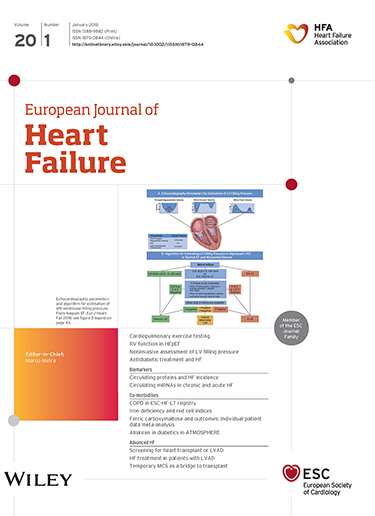Lower extremity lymphatic flow is associated with diuretic response in acute heart failure
IF 16.9
1区 医学
Q1 CARDIAC & CARDIOVASCULAR SYSTEMS
引用次数: 0
Abstract
AimsThe dysfunctional lymphatic system appears to play an important role in the development and progression of congestion in heart failure. We hypothesized that in acute heart failure (AHF), diuretic efficacy is associated with peripheral lymph flow.Methods and resultsWe prospectively studied AHF patients who received protocolized diuretics followed by assessment of lower limb flow using indocyanine green lymphangiography (a validated method for visualization of lymphatic drainage). The lymph flow was defined as ‘present’ when it reached the ankle and ‘significant’ when it reached >10 cm within 10 min of dye injection, respectively. Based on diuretic efficacy (defined as cumulative diuresis and weight loss), patients were classified as diuretic responders vs. non‐responders. Overall, 65 patients (mean age: 67 ± 15 years, median [Q1–Q3] N‐terminal pro‐B‐type natriuretic peptide: 6901 [4478–12 723] pg/ml) were examined. There were 43 (66%) diuretic responders and 22 (34%) non‐responders who did not differ in baseline clinical/laboratory characteristics. Among the responders, there were more patients with lymph flow either ‘present’ or ‘significant’ (95% vs. 73% and 88% vs. 45% vs non‐responders, respectively,急性心力衰竭患者下肢淋巴血流与利尿反应相关
目的功能失调的淋巴系统似乎在心力衰竭充血的发生和发展中起重要作用。我们假设在急性心力衰竭(AHF)中,利尿功效与周围淋巴流动有关。方法和结果我们前瞻性地研究了AHF患者,这些患者接受了方案规定的利尿剂,然后使用吲哚菁绿淋巴管造影(一种有效的淋巴引流可视化方法)评估下肢血流。在注射染料后10分钟内,到达脚踝处的淋巴流被定义为“有”,到达10cm处的淋巴流被定义为“显著”。根据利尿效果(定义为累积利尿和体重减轻),将患者分为利尿反应者和无反应者。总的来说,65例患者(平均年龄:67±15岁,中位[Q1-Q3] N端前B型利钠肽:6901 [4478-12 723]pg/ml)被检查。有43例(66%)利尿剂应答者和22例(34%)无应答者在基线临床/实验室特征上没有差异。在应答者中,有更多的患者有“存在”或“显著”的淋巴流(分别为95% vs. 73%和88% vs. 45% vs.无应答者)。0.01)。应答者在10分钟内到达淋巴的中位距离明显更长(50[24-75]比10 [3-38]cm;p & lt;0.0005)。淋巴流量与6小时利尿之间存在显著的关联,β(标准误差)为0.45 (0.13)(p <;0.005)。在多变量分析中,淋巴流动距离(优势比1.48,95%可信区间1.08-2.03)独立预测利尿剂疗效(p <;0.05)。结论AHF患者下肢淋巴流动速度加快,利尿效果较好。淋巴系统能否成为去充血的治疗靶点还需要进一步的研究。
本文章由计算机程序翻译,如有差异,请以英文原文为准。
求助全文
约1分钟内获得全文
求助全文
来源期刊

European Journal of Heart Failure
医学-心血管系统
CiteScore
27.30
自引率
11.50%
发文量
365
审稿时长
1 months
期刊介绍:
European Journal of Heart Failure is an international journal dedicated to advancing knowledge in the field of heart failure management. The journal publishes reviews and editorials aimed at improving understanding, prevention, investigation, and treatment of heart failure. It covers various disciplines such as molecular and cellular biology, pathology, physiology, electrophysiology, pharmacology, clinical sciences, social sciences, and population sciences. The journal welcomes submissions of manuscripts on basic, clinical, and population sciences, as well as original contributions on nursing, care of the elderly, primary care, health economics, and other related specialist fields. It is published monthly and has a readership that includes cardiologists, emergency room physicians, intensivists, internists, general physicians, cardiac nurses, diabetologists, epidemiologists, basic scientists focusing on cardiovascular research, and those working in rehabilitation. The journal is abstracted and indexed in various databases such as Academic Search, Embase, MEDLINE/PubMed, and Science Citation Index.
 求助内容:
求助内容: 应助结果提醒方式:
应助结果提醒方式:


